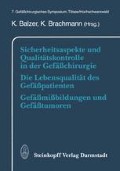Zusammenfassung
Immer dann, wenn Selbstverständlichkeiten thematisiert werden, ist Aufmerksamkeit geboten, weil Kontoverses aus dem Blick zu geraten droht. So zielt aus der Sicht des unbefangenen Menschen therapeutisches Handeln fraglos auf eine Verbesserung der Lebensqualität ab, in dem Sinne, daß es ihm nach der Behandlung besser gehen soll als vorher. Die Behandlung soll nützlich sein; und von therapeutischem Nutzen spricht man dann, wenn die Summe der positiven Effekte größer ist als die der negativen Folgen und Begleitumstände.
Access this chapter
Tax calculation will be finalised at checkout
Purchases are for personal use only
Preview
Unable to display preview. Download preview PDF.
Literatur
Aaronson N, Ahmedzai S, Bullinger M et al. (1991) The EORTC core quality-of-life questionnaire: Interim results of an international field study. In: Osoba D (ed) Effect of cancer on quality of life. CRC Press, Boca Raton Boston Ann Arbor London
Albers M, Ayrton C, de Luccia N (1992) Assessment of quality of life of patients with severe ischmia as a result of infrainguinal arterial occlusive disease. Vasc Surg 16: 54–59
Brickman P, Coates D, Lanoff-Bulman R (1978) Lottery winners and accident victims: Is happiness relative? J of Personality and Social Psychology 36: 917–927
Croog CJ, Levine S, Tsta MA et al. (1973) Side effects on hypotensive agents evaluated by a selfadministered questionnaire. Br Med J 3: 485
Epikur, zitiert nach Swoboda H (1973) Die Qualität des Lebens. Suhrkamp, Frankfurt, S 87
Glatzer E, Zapf W (1984) Lebensqualität in der Bundesrepublik. Darmstadt: Wissenschaftliche Buchgesellschaft
Gelber RD, Goldhirsch A (1986) A new endpoint for the assessment of adjuvant therapy in postmenopausal women with operable breast cancer. J Clin Oncol 4: 1772–1779
Hunt SM, McKenna SP, McEwen J et al. (1981) The Nottingham health profile: Subjective health status and medical consultations. Soc Sc Med 15: 221
Hunt SM, McEwen J, McKenna SP et al. (1982) Subjective health of patients with peripheral vascular disease. Practitioner 226: 133–136
Karnofsky DA, Abelmann WH (1948) The use of nitrogen mustards in the palliative treatment of carcinoma. Cancer 56: 634
Kuchler Th, Schreiber HW (1991) Lebensqualität in der Allgemeinchirurgie. Hamburger Ärzteblatt: 246–250
Rosser R, Kind P (1978) A scale of valuations of states of illness. is there a social consensus? Int J Epidemiol 7: 347–358
Schwarz R, Ruoff G (1989) Meßmethoden der postoperativen Lebensqualität. Chirurg 60:871 — 975
Schwarz R, Flechtner H, Kuchler Th, Bernard J, Hürny Ch (1991) Lebensqualität in der Onkologie. Zuckschwerdt, München Bern Wien San Francisco
Solschenizyn A (1968) Die Krebsstation. Luchterhand, Neuwied Berlin
Spiegel D, Bloom J, Kraemer HC et al. (1989) Effect of psychosocial treatment on survival of patients with metastatic breast cancer. Lancet 2: 888–891
Spitzer WO, Dobson AJ, Hall J (1981) Measuring the quality of life of cancer patients. J Chron Dis 34: 585–597
Stewart AL, Hays RD, Ware JE (1988) The MOS short-form general health survey: Reliability and validity in a patient population. Medical care 26: 724
Troidl H, Kusch J, Vestweber KH, Eypasch E, Koeppen L, Bouillion B (1987) Quality of life: An important endpoint both in surgical practice and research. J Cron Dis 40: 523–528
Westhoff G (1993) Handbuch psychosozialer Meßinstrumente. Verl. f. Psychologie, Göttingen
Author information
Authors and Affiliations
Editor information
Editors and Affiliations
Rights and permissions
Copyright information
© 1994 Dr. Dietrich Steinkopff Verlag, GmbH & Co. KG Darmstadt
About this paper
Cite this paper
Schwarz, R. (1994). Lebensqualität als therapeutisches Ziel bei arterieller Verschlußkrankheit aus psychosozialer Sicht. In: Balzer, K., Brachmann, K. (eds) Sicherheitsaspekte und Qualitätskontrolle in der Gefäßchirurgie Die Lebensqualität des Gefäßpatienten Gefäßmißbildungen und Gefäßtumoren. Steinkopff. https://doi.org/10.1007/978-3-642-51749-5_13
Download citation
DOI: https://doi.org/10.1007/978-3-642-51749-5_13
Publisher Name: Steinkopff
Print ISBN: 978-3-642-51750-1
Online ISBN: 978-3-642-51749-5
eBook Packages: Springer Book Archive

